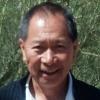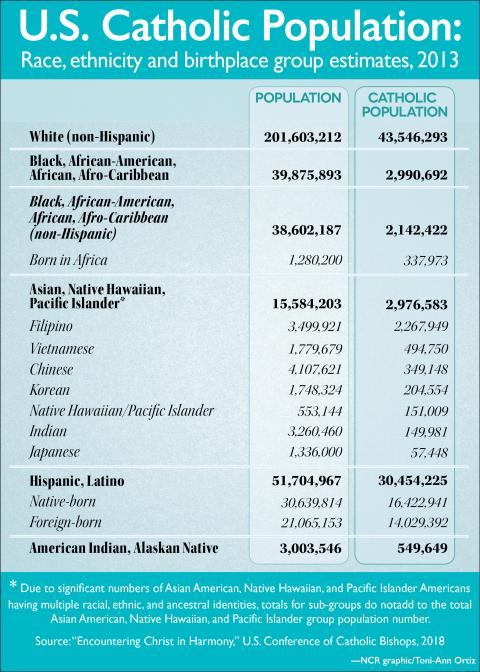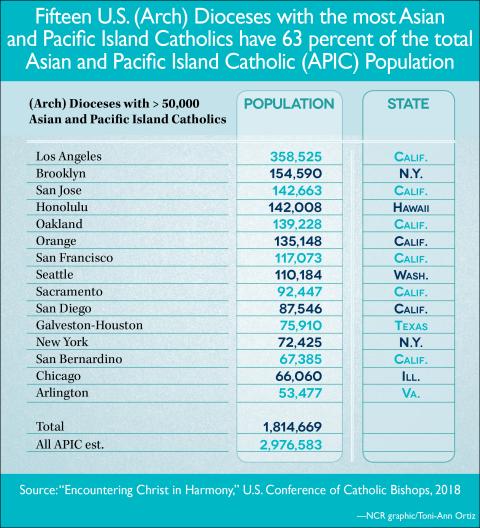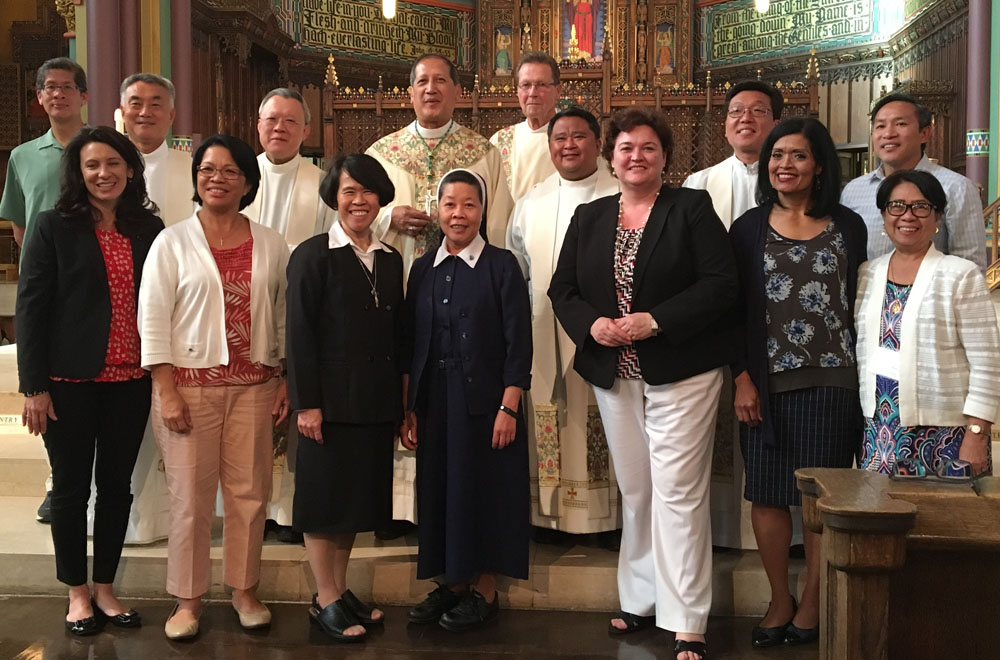
Bishop Oscar Solis (fourth from the left, top row), meets with experts and leaders who minister to Asian and Pacific Islander Catholics, in October in Salt Lake City. (Courtesy of the Secretariat of Cultural Diversity in the Church)
On an empty field south of the Mary Queen of Vietnam Church in east New Orleans stands a 23-foot marble statue of Our Lady of La Vang, that a church official said will turn into a Marian pilgrimage site for Vietnamese Catholics in the southern states of Alabama, Mississippi and Louisiana.
Tony Tran, coordinator of the Vietnamese Catholics Office of the New Orleans Archdiocese, said that Vietnamese Catholics have a "special devotion" to Mary.
"She has a special place in our heart," he said. "Our devotion has become a part of our culture. That is why we will develop this 28-acre church property into a Marian shrine as well as a pilgrimage site."
The statue was carved from one piece of solid marble in Vietnam and then shipped to New Orleans this summer, he said, adding that the statue will be placed on an 11-foot foundation. A park will be developed around the statue in the coming year.
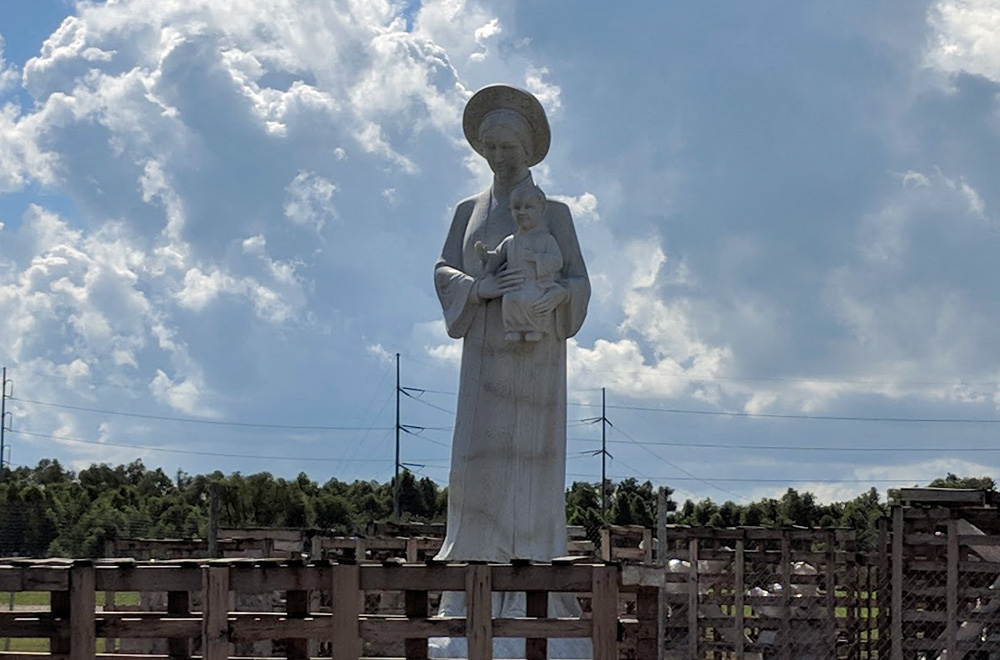
The statue of Our Lady of La Vang in New Orleans (Peter Tran)
"Our Archbishop Gregory Aymond has always encouraged the various ethnic communities, including the Vietnamese community, to express faith through our culture," Tran said.Tran, 56, arrived in the U.S. as a refugee in 1981, and said Vietnamese Catholics identify themselves with the devotion to Mary.
"This is our identity. Through this shrine we hope to promote our way of life and our culture," he said. "We also hope to use this shrine as a way of evangelization."
Tran said that the devotion to Mary resonates with the recent document from the U.S. Catholic bishops' conference, "Encountering Christ in Harmony: A Pastoral Response to Our Asian and Pacific Island Brothers and Sisters." The document, seen as a pastoral response to the some 3 million Asian and Pacific Islander Catholics, was adopted by the U.S. bishops at their 2018 spring assembly.
Paulist Fr. Ricky Manalo, one of two Asian theological consultors for the document, said that this document follows up the 2001 U.S. bishops' statement "Asian and Pacific Presence: Harmony in Faith."
"That document called us to be aware of the API [Asian and Pacific Islander] Catholic presence in the United States. This document goes a little further," he said, by addressing four areas of "pastoral response" to Asian and Pacific Islander Catholic communities. (See NCR graphic of data from the document "Encountering Christ in Harmony.")
"The first section is identity. This section gives us information on how we recognize the gifts, devotion, worship and practices of each Asian community," Manalo said. "Then we addressed the first and second generations, their challenges and difficulties. We also call on each Asian community to build leadership whether they are clergy, religious or laypeople. Finally, we used Pope Francis' apostolic exhortation Evangelii Gaudium as a paradigm when he talked about how we encounter different culture that leads us to dialogue."
At the end of each section, the document gives practical suggestions to national, diocesan and parish leaders for welcoming and engaging Asian and Pacific Islander brothers and sisters to live a life of faith in the Catholic Church, added Manalo, who also teaches at Santa Clara University.
At the fifth annual retreat of American Karenni Catholics in Phoenix in late July, Juliana Nga Meh, 19, recalled how she stood up during the open dialogue session between parents and young people.
"I was nervous to talk to the elderly and everyone. With tears in my eyes, I told them that as children we appreciate their sacrifice in protecting us in the refugee camp, bringing us into this country, teaching us to live in our faith, and taking care of us here," she said. "Our hearts are filled with gratitude. But as we grow older here, we live in a new situation with a new way of living. We know that they want us to succeed, to work hard in school and at work. But sometimes we need to be ourselves, and we ask them to be patient and understanding [of] our situation."
Nga Meh, a student at Arizona State University, said parents were receptive to the talk, but asked that children not "abandon their culture."
Scalabrinian Sr. Myrna Tordillo, assistant director of Asian and Pacific Island Affairs for the Secretariat of Cultural Diversity in the Church for the U.S. bishops' conference, attended the Karenni retreat and said that such a dialogue forum is one of the recommendations from the document for church leaders to carry out in local Catholic communities.
Such a forum of pastoral workshops and ministerial programs have been happening for the Lao Catholic community nationwide, according to Charity Sr. Alice Thepouthay, director of the Milwaukee-based Lao Pastoral Center.
Her office, established in the early 1980s to provide pastoral care for Lao Catholics in the U.S., has sponsored national meetings for Lao Catholics to help them integrate in their local church. Thepouthay, who in the last few years has aided Karenni refugees in Milwaukee, said that her past experience has helped them not only with pastoral care, but also with housing, jobs, school and health care.
Thepouthay said that the "Encountering Christ in Harmony" document can be useful if it reminds Catholics in local dioceses and parishes to be a welcoming church.
"On Sunday Mass, look around us," she said. "There are people of different colors. We need to get out of our own comfort zone and reach out to them and help them feel as a part of the church." (See NCR graphic of data from the document "Encountering Christ in Harmony.")
Manalo, also a liturgical composer, insisted that the "Encountering Christ in Harmony" document is not only for Asian and Pacific Islander communities, but for the whole U.S. church. The document encourages intercultural dialogue in dioceses, parishes, schools and Catholic institutions.
Tordillo said there is a plan to disseminate and implement the "Encountering Christ in Harmony" pastoral response in U.S. dioceses, Asian and Pacific Islander communities, and Catholic organizations and educational institutions.
In October, Salt Lake City Bishop Oscar Solis convened a meeting in Salt Lake City with Asian and Pacific Islander leaders who minister to Asian and Pacific Islander Catholics. During the meeting, the group outlined a strategy to implement "Encountering Christ in Harmony." The strategy includes developing traditional and web-based resources (such as a parish kit to help explain the document); creating a website as a resource for materials; making the bishops' document available online; developing models for education and formation to be used in dioceses, local parishes and Asian and Pacific Islander Catholic groups; and establishing a national young adult and youth advisory volunteer committee.
Some diocesan directors of multicultural offices have already begun to implement the newly approved pastoral response.
Corinne Monogue, director of the Office of Multicultural Ministries for the Diocese of Arlington, Virginia, said that the diocese has numerous Asian and Pacific Islander communities, including Vietnamese, Korean, Filipino, Chinese, Indian, Indonesian, Burmese and Samoan.
She said her office is looking for ways to implement suggestions for engagement in each document chapter; the ministries office is inviting chancery offices such as youth ministry, vocations and family life to engage Asian and Pacific Islander speakers for diocesan related events. She also plans to communicate to the various offices in the chancery about the API document so they in turn reach out to pastors in the diocese to ensure that they include the Asian and Pacific Islander Catholics in their parishes.
According to the latest census data, Hawaii has about 1.4 million people: 37.8 percent Asian, 25.7 percent white, 10.2 percent Hawaiian or other Pacific Islanders, 10.5 percent Hispanic or Latino, 2.2 percent African-American and some 23.8 percent claiming two or more races. Filipino Catholics are the Asian majority in the diocese, according to Jayne Mondoy, director of the Office of Religious Education for the Diocese of Honolulu.
As an Asian born and raised in Hawaii, Mondoy said she appreciated the way the document helps readers to break down the "monolithic identity often associated with the terms Asian and Pacific Islander while providing practical pathways toward encounter, including intergenerational encounters, understanding differences, finding common ground, and the development of a more inclusive community."
In her personal experience, she said the widespread use of the term Asian and Pacific Islander is a recent phenomenon. Asian and Pacific Islanders in Hawaii commonly identify with a specific ethnic group, such as Chinese, Filipino, Korean, Vietnamese, Hawaiian, Samoan and Chuukese, and each has a particular religious identity and unique expressions of the faith.
Mondoy applauds the document for describing key distinctions and commonalities of the cultural tapestry, and for celebrating the diversity of each of its heritages and traditions.
Advertisement
Mondoy wrote an article in the Hawaii Catholic Herald and shared the document with Asian and Pacific Islander leaders, including young adults. She also hopes to introduce the document during diocesan faith formation conferences.
"[The document] will foster a greater understanding for the richness, uniqueness, gifts and contributions that so many API Catholics make each day to the body of the U.S. Church," said Monogue. "It welcomes API Catholics, understanding their cultural identity, history, traditions and values. It invites API Catholics into every aspect of a Catholic faith-based life, and provides valuable suggestions, at all levels, for inclusion and awareness."
[Peter Tran is a former editor of the Union of Catholic Asian News at the main editorial office in Bangkok. He was involved for some 20 years with refugee ministry in the United States and at the Vatican. He is now assistant director of the Redemptorist Renewal Center in Tucson, Arizona.]
